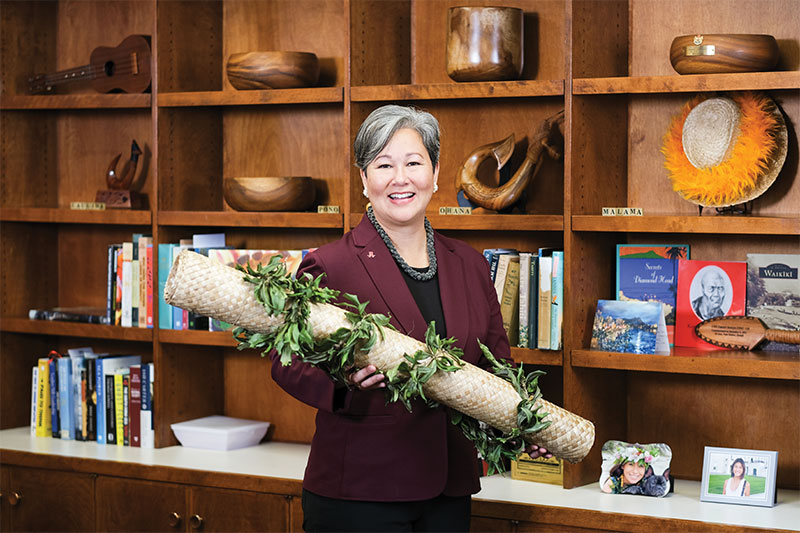First And Foremost
More than just being the first woman and Native Hawaiian ever appointed as president of East-West Center, Suzanne Vares-Lum is the right leader at a time when building relationships is key in the Indo-Pacific region.
“Don’t listen to the barking dogs.” That’s a piece of advice Suzanne Vares-Lum received when she was seated at an all-female round-table some time ago. Said by a Mongolian parliamentarian, the story went on to explain how families in the East Asia country must be fairly nomadic given the region’s harsh weather patterns, and when traveling from place to place, they often encounter hungry and vicious canines. If they were to stop for every single one, they would never reach their destination.
“What she was really saying to the group of women was that if you listen to the chatter that says you can’t — or even your own internal voice that’s saying you can’t — you won’t get to where you’re going,” says Vares-Lum. “You have to listen to the more positive voices, not the barking dogs.”
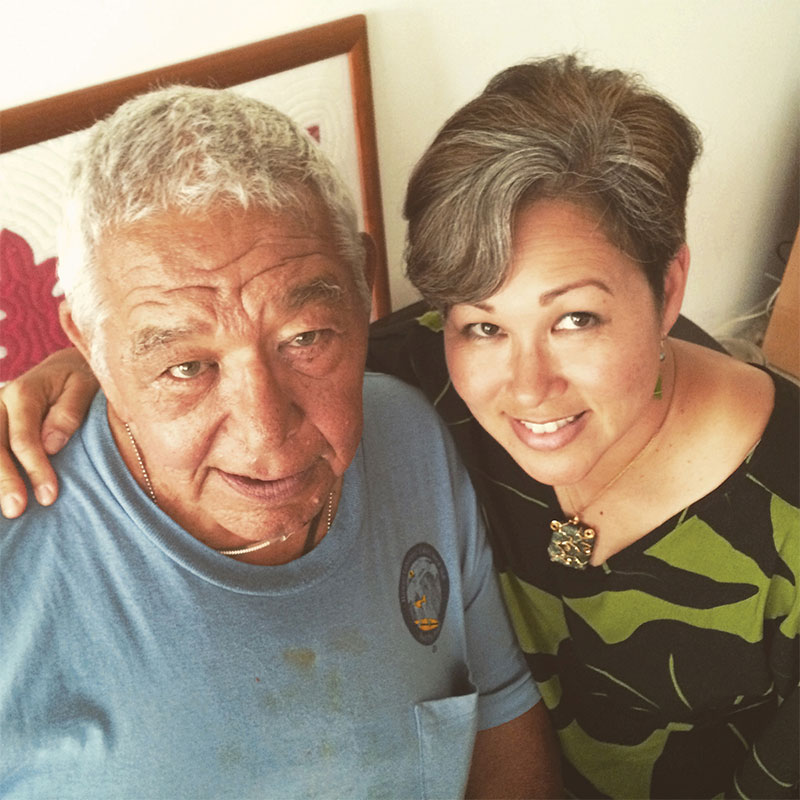
Suzanne Vares-Lum with her late father, Sgt. 1st Class Adelino Conrad Vares, who inspired her to join the military. PHOTO COURTESY SUZANNE VARES-LUM
These words of wisdom have stuck with the Wahiawā-born Vares-Lum as she has surpassed what was once deemed far-fetched or even impossible.
She’s no stranger to being the only woman in the room, but with her courage, determination and altruism at the forefront of everything she does, she’s been named the “first” of a remarkably long list of prestigious titles over her 34-year career. To name just a few, she was the first Native Hawaiian female to become a U.S. Army general and, most recently, she’s the first woman and Native Hawaiian appointed president of East-West Center.
As she sits in her new office that overlooks the lush grounds of University of Hawai‘i at Mānoa, Vares-Lum reflects on a time when she was a student walking these same sidewalks. It’s the place where she met her husband, Courtney — they share two daughters now — and where she earned degrees in journalism and education.
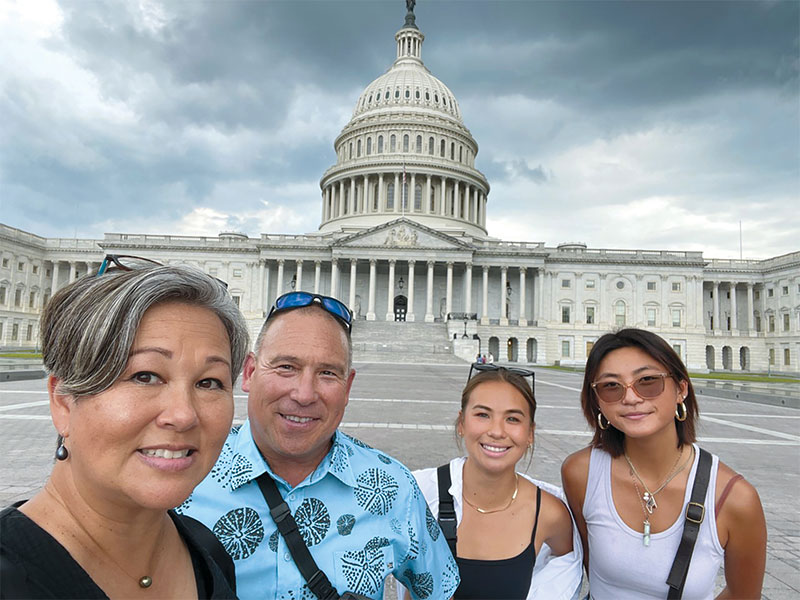
Spending time with husband Courtney and daughters Diana and Connie at the Capitol in Washington, D.C.
PHOTO COURTESY SUZANNE VARES-LUM
While a career in writing piqued her interest for a period of time — she was on the Ka Leo O Hawai‘i staff after all — Vares-Lum decided to follow in her father’s mighty and brave footsteps and pursue a life of service.
“I think what really impressed me was the World War II generation, those who were willing to serve our country and stand up to protect and preserve our interests, even if it meant the ultimate sacrifice,” says Vares-Lum. “The courage to support one another has always impacted me.”
She joined the Army Reserves, UH’s ROTC program and later commissioned as a second lieutenant, entering active duty as a military intelligence officer. Her first of many overseas assignments was to Germany during the Cold War.
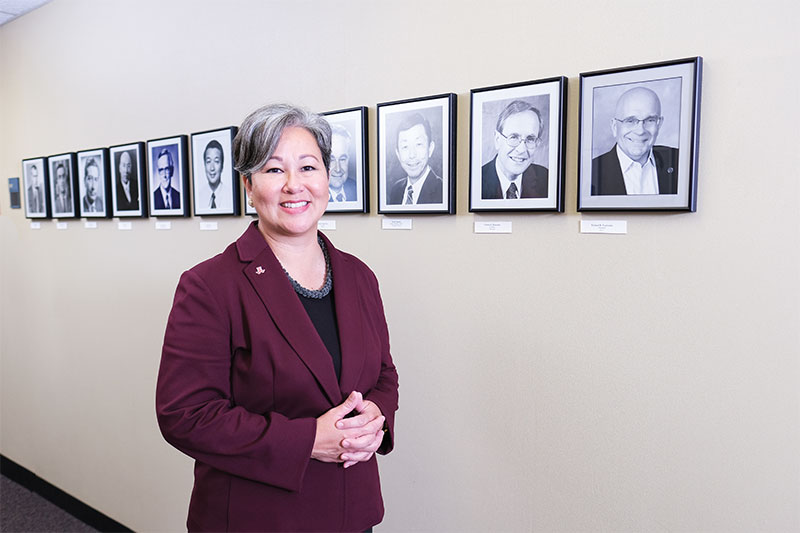
Despite East-West Center’s male-dominated history, its newest president, Suzanne Vares-Lum, is quite comfortable being the first woman to lead the institution forward.
“It was East and West Germany when I was there and… my first assignment was as a fire support intelligence officer for the 3rd Infantry Division Artillery unit. There were very few females back then,” she explains. “In the ’80s-’90s, there were many restrictions on women in terms of what kind of roles we could take. I worked as one of the few female officers in that unit, but it taught me a lot.”
Vares-Lum continued to advance — and by doing so, break barriers — and eventually worked her way into leadership positions, never paying much attention to the barking dogs. She credits much of her success to the bridges she built along the way, perhaps foreshadowing the duties she would undertake decades later.
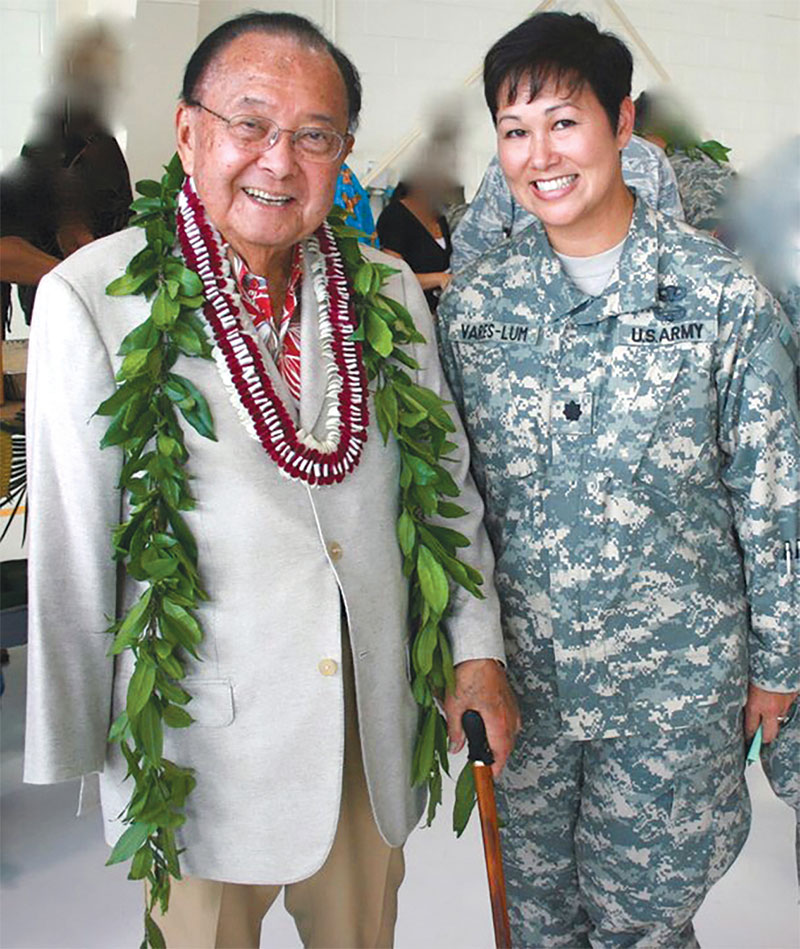
The late U.S. Sen. Daniel K. Inouye and then-lieutenant colonel gather for a photo opportunity during a helicopter dedication ceremony for Hawai‘i National Guard. PHOTO COURTESY SUZANNE VARES-LUM
“I had to work through understanding that I had something to contribute,” she says. “I built a network of friends, many of them male, that encouraged me. I had mentors that I sought out who were willing to see beyond the exterior or how I was born. They were able to see that I had something to offer and to help better the organization.
“I think building relationships is key, which really brings me back to the (East-West) Center, right? By building relationships, you can have the courage to overcome what people think and the boxes that people want to put you in, or even cultural boxes that we want to put people in throughout the region,” she continues. “If we understand more, then maybe we’ll think of the possibilities rather than the limitations. I feel like having those relationships with amazing people that I’ve got to work with over the years helped me to realize that I don’t need to limit myself in these boxes.”
In the years following, she came back to her island home to join the Hawai‘i National Guard, where she was a part of the 29th Infantry Brigade. In 2004, the unit was mobilized for Operation Iraqi Freedom 3 — the first time it was called upon for combat since Vietnam.
Thinking back on her time in the Middle East, Vares-Lum says, “In terms of a number, there were dozens of attacks a day across Iraq, and at least four to five times a week, we had indirect fire from rockets to Balad because we really didn’t have a very good strategy. As a result of that, the 29th Infantry Brigade lost 18 in that whole year of deployment. One was one of my own soldiers, Sgt. Deyson Cariaga. He was not even 21.”
By witnessing the harrowing ramifications of warfare firsthand, Vares-Lum offers a perspective to the center that it hasn’t quite seen before.
“Somebody asked me, being the president of East-West Center — a place where it is neutral ground to have dialogues about issues that relate to the region — if having a military officer in this position seems counterintuitive. But, really, if we think about it, a military officer who has seen the consequences and cost of war would say, just as I would say, that we should do everything in our power to prevent using the element of national power in the military, and ensure that we’ve done all things possible — whether it’s dialogue, education or exchange — to ensure that we have that understanding.
“In 1960, this center was born out of this era of post-World War II — which had significant consequences — Korean War and a buildup into the Vietnam War for the United States. It really was born out of this idea that the United States, Asia and the Pacific needed to understand one another more, and we could do this if there were more people-to-people relationships. If more people understood one another’s nations, cultures and how to exchange, we could solve conflicts, historical grievances, challenges or crises together.”
For the last segment of her military career, Vares-Lum moved on to the U.S. Indo-Pacific Command, where she cultivated key relationships locally, inAsia and what she calls “the blue continent” or the Pacific, as well as spoke on key issues including leadership and mentorship, and women, peace and security. Following her retirement last June, she assumed her position at East-West Center in January.
At the inaugural ceremony, Vares-Lum received a lauhala mat that symbolizes “responsibility for a community that’s woven together by many strands, as well as a place where people can sit together to build a better world.” The event’s theme, meanwhile, was ka ulana ‘ana i ka piko (in weaving, you begin at the center).
“Just as the weaver brings together many fibrous strands and turns them into something beautiful, strong and valuable, the East-West Center is about bringing diverse people and perspectives together, weaving together a community of our students, participants and center staff,” notes Vares-Lum. “In turn, these alumni are then woven into a greater community across the Indo-Pacific region, forging stronger bonds across cultures, nationalities and perspectives.”
At the core of her mission, Vares-Lum shared in her opening speech that she hopes to collectively accomplish combating the effects of the pandemic and climate change; support effective governance, public accountability and human rights; and create new knowledge and foster new ideas to promote freedom, prosperity, peace and dignity.
“Being a daughter of this region, I felt like I could connect very well with our regional brothers and sisters, you could say,” says the ‘Aiea High School graduate. “When this opportunity came up, I just loved the idea of building bridges and making connections so we can help develop future leaders and relationships that will help us to address the critical issues of the region.”
Staff members of East-West Center beam with nothing shy of admiration for Vares-Lum, who’s known by most as Suzy, an2d explain how she’s “hit the ground running.” And when all has been said and done, there’s no doubt the feats Vares-Lum will carry out are going to be louder than any noise the barking dogs can muster.


